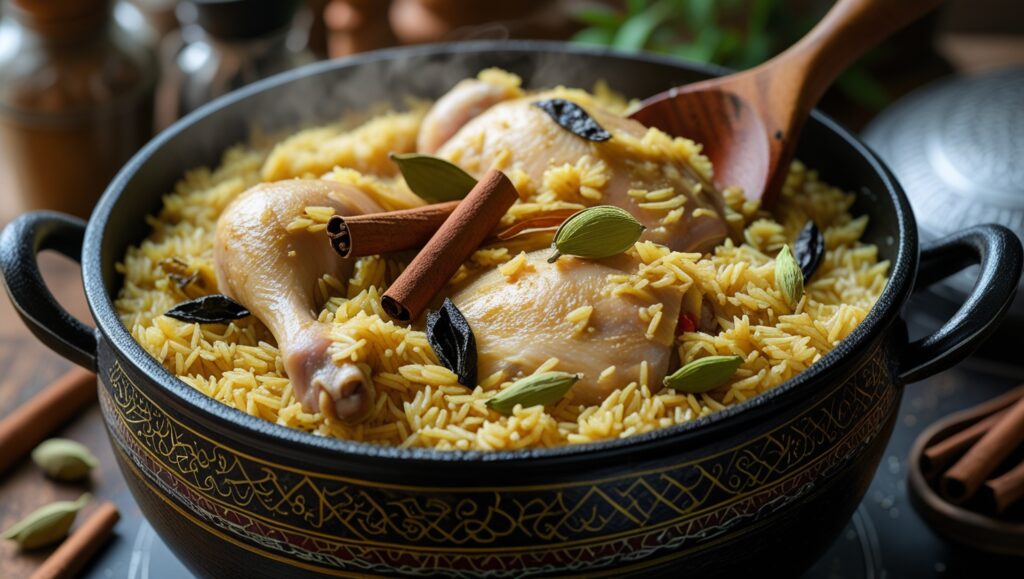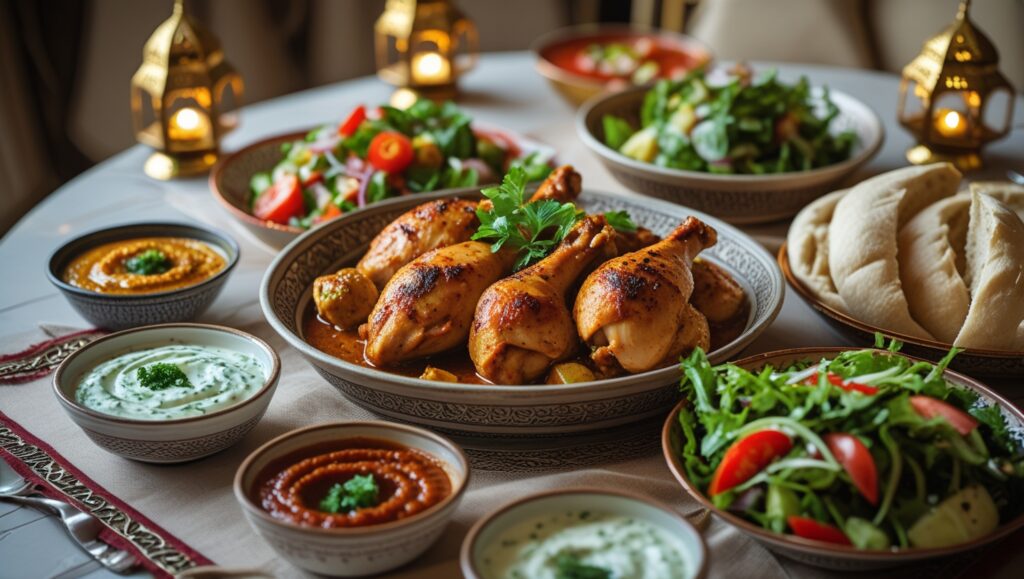Introduction
If you’re craving a dish that’s packed with bold flavors, fragrant spices, and succulent chicken, look no further than Chicken Kabsa. This traditional Saudi Arabian dish is a one-pot meal that blends tender chicken with aromatic rice, making it a beloved staple across the Middle East.
In this guide, we’ll dive deep into everything about Chicken Kabsa—its origins, ingredients, step-by-step preparation, and variations. You’ll also learn expert tips to perfect your Kabsa, its health benefits, and the best ways to serve it. Whether you’re a seasoned cook or a beginner, this guide will help you create an authentic, mouthwatering Chicken Kabsa at home.
Introduction to Chicken Kabsa
What is Chicken Kabsa?
Chicken Kabsa is a flavorful rice and chicken dish that originates from Saudi Arabia. Often considered the national dish, it’s a combination of fragrant basmati rice, spiced chicken, and a rich blend of Arabic spices. What makes Kabsa unique is its slow-cooked chicken, infused with cardamom, cinnamon, black lime, bay leaves, and saffron, creating an irresistible aroma and depth of flavor.
Unlike other Middle Eastern rice dishes like biryani or machboos, Kabsa relies on slow-cooked chicken and deeply infused rice, making it incredibly aromatic and tender. The dish is often garnished with roasted nuts, raisins, and fresh herbs for an extra layer of texture and sweetness.
The Cultural Significance of Kabsa in Saudi Arabia
Kabsa isn’t just food—it’s tradition. In Saudi Arabia, Kabsa is a symbol of hospitality and generosity, often served at family gatherings, celebrations, and special occasions. It’s a dish that brings people together, fostering a sense of community.
Traditionally, Kabsa is served on a large communal platter, where everyone eats together using their hands, embracing the authentic Arabian dining experience. While modern adaptations use plates and utensils, the essence of sharing and togetherness remains an integral part of enjoying this dish.
Variations of Chicken Kabsa Across the Middle East
Although Chicken Kabsa is most commonly associated with Saudi Arabian cuisine, different Middle Eastern and Gulf countries have put their spin on this classic dish:
- Machboos (Kuwait, Bahrain, UAE) – A similar dish but often includes dried black limes for an added citrusy tang.
- Mandi (Yemen) – Uses smoky, slow-cooked meat, traditionally prepared in a tandoor-style underground oven.
- Kabuli Pulao (Afghanistan) – A close cousin, but uses lamb, carrots, and nuts for a sweeter profile.
- Jordanian Mansaf – Uses fermented yogurt sauce (jameed) to enhance the richness of the dish.
These variations highlight the versatility of Chicken Kabsa, making it an adaptable dish that reflects the rich culinary heritage of the Middle East.
Ingredients and Spices Used in Chicken Kabsa words
When it comes to making authentic Chicken Kabsa, the secret lies in its ingredients and spices. The combination of fresh produce, fragrant spices, and quality chicken creates the signature depth of flavor that makes this dish unforgettable.
Key Ingredients for Chicken Kabsa
To prepare it , you’ll need the following:
- Chicken – Bone-in chicken pieces, such as thighs, drumsticks, or a whole cut-up chicken, provide the best flavor.
- Basmati Rice – This long-grain rice absorbs the rich spices and broth beautifully.
- Tomatoes & Tomato Paste – These add richness and depth to the dish’s base.
- Onions & Garlic – Essential for building a savory flavor foundation.
- Carrots – Grated or julienned, they add sweetness and a pop of color.
- Green Chilies – Optional, but they provide a mild heat.
- Chicken Broth – Cooking the rice in a seasoned broth enhances its taste.
- Ghee or Oil – Used for sautéing and enhancing the authentic Arabian aroma.
Essential Spices for Authentic Kabsa Flavor
The magic of Chicken Kabsa comes from its unique blend of warm spices, which give the dish its aromatic and earthy taste. Here are the key ones:
- Cardamom – Adds a slightly sweet, floral aroma.
- Cinnamon Sticks – Infuses the dish with a warm and spicy undertone.
- Black Lime (Loomi) – A distinct ingredient that gives Kabsa its citrusy and smoky flavor.
- Bay Leaves – Enhances the complexity of the broth.
- Cumin & Coriander – These earthy spices add warmth and nuttiness.
- Paprika & Turmeric – Provide color and mild spice.
- Cloves – Just a few give a deep, intense flavor.
- Saffron – A luxurious ingredient that enhances the golden hue of the rice.
Alternative Ingredients for a Unique Twist
Want to experiment with your Chicken Kabsa? Here are some fun variations:
- Swap chicken for lamb or beef for a richer taste.
- Use brown rice or quinoa for a healthier version.
- Add dried fruits like raisins or dates for a hint of sweetness.
- Experiment with nuts like almonds or cashews for extra crunch.
Step-by-Step Chicken Kabsa Recipe

Now that we’ve covered the ingredients, let’s get cooking! Follow this step-by-step guide to make a delicious Chicken Kabsa at home.
Preparing the Chicken – Marinade and Cooking Tips
- Marinate the Chicken – Mix yogurt, garlic, ginger, lemon juice, salt, and Kabsa spices. Let the chicken marinate for at least 30 minutes (overnight is even better!).
- Sear the Chicken – Heat ghee or oil in a large pot, then brown the chicken on all sides. This step locks in flavor.
- Set Aside – Once golden, remove the chicken and set it aside while preparing the base.
How to Make Kabsa Rice – Cooking Methods & Flavoring Techniques
- Sauté the Aromatics – In the same pot, add chopped onions, garlic, and grated carrots. Cook until soft.
- Add the Spices – Toss in cardamom, cinnamon, bay leaves, and black lime. Stir well until fragrant.
- Tomatoes & Tomato Paste – Add chopped tomatoes and tomato paste, cooking until the mixture thickens.
- Return the Chicken – Place the seared chicken back into the pot and cover with chicken broth. Let it simmer for 30–40 minutes until the chicken is tender.
- Cook the Rice – Remove the chicken, then add washed basmati rice to the pot. Let it absorb all the flavors as it cooks in the broth.
- Final Touches – Return the chicken on top of the rice, cover, and let it steam for 10 more minutes for full flavor infusion.
Serving and Garnishing – Nuts, Raisins, and Side Dishes
Once your Chicken Kabsa is ready, it’s time to serve it!
- Fluff the rice and arrange the chicken on top.
- Garnish with toasted almonds, cashews, and raisins for an authentic touch.
- Serve with fresh salad, yogurt sauce, or spicy tomato salsa (Shattah) for an extra burst of flavor.
Variations of Chicken Kabsa
While the traditional Chicken Kabsa is a well-loved dish across Saudi Arabia, many regions have their own unique spin on this flavorful meal. Whether you prefer a different protein, a healthier option, or a bolder flavor, there’s a variation of Kabsa to suit your taste!
Traditional Saudi Chicken Kabsa vs. Other Versions
The classic Saudi traditional spiced chicken is made with slow-cooked chicken, fragrant basmati rice, and a blend of warm spices. However, in different parts of the Middle East, slight modifications create distinct flavors:
- Kabsa Lahm – Made with lamb instead of chicken for a richer taste.
- Mandi (Yemen) – Uses smoky, tandoor-cooked meat, often served with a side of yogurt sauce.
- Machboos (Kuwait, UAE, Bahrain) – Includes dried black limes, giving it a slightly tangy taste.
Chicken Machboos – The Gulf’s Take on Kabsa
Machboos is similar to Chicken Kabsa, but it often includes:
- Softer spices like cinnamon and nutmeg instead of a bold spice mix.
- Dried black lime (loomi) for a more citrusy, smoky flavor.
- A richer broth, creating a deeper color and a slightly different texture.
Vegetarian and Seafood Kabsa Alternatives
If you’re looking for a twist on Chicken Kabsa, consider these delicious alternatives:
- Vegetable Kabsa – Swap chicken for chickpeas, eggplant, and bell peppers for a hearty vegetarian dish.
- Seafood Kabsa – Use shrimp or fish instead of chicken for a coastal-inspired version.
- Quinoa Kabsa – A low-carb alternative that still keeps the authentic flavors.
Health Benefits and Nutritional Value of Chicken Kabsa
Not only is Chicken Kabsa a feast for the senses, but it’s also a nutritious, well-balanced meal. The dish provides a good mix of protein, fiber, and essential vitamins, making it a wholesome choice.
Caloric and Macronutrient Breakdown
The nutritional value of Chicken Kabsa depends on portion size and ingredients, but here’s an estimate per serving:
- Calories: ~500-600 kcal
- Protein: ~35g (from chicken and nuts)
- Carbohydrates: ~75g (from basmati rice)
- Fats: ~15g (from ghee, nuts, and chicken skin)
- Fiber: ~5g (from vegetables and whole spices)
For a healthier version, reduce oil and ghee, opt for brown rice, and add more vegetables.
Health Benefits of the Spices Used in Kabsa
The spices in Chicken Kabsa don’t just add flavor—they also offer several health benefits:
- Cardamom & Cinnamon – Help with digestion and blood sugar regulation.
- Turmeric – Has anti-inflammatory properties and boosts immune health.
- Black Lime (Loomi) – A great source of antioxidants that support heart health.
- Garlic & Onions – Strengthen the immune system and help with detoxification.
Tips for Making a Healthier Version of Chicken Kabsa
Want to enjoy Chicken Kabsa guilt-free? Here are some simple modifications:
- Use skinless chicken breast for a leaner protein source.
- Reduce ghee and oil, replacing them with a small amount of olive oil.
- Increase the vegetable content for added fiber and vitamins.
- Serve with yogurt or a fresh salad instead of heavy sauces.
Tips for Perfecting Your Chicken Kabsa
Making this recipe at home can be a rewarding experience, but a few small mistakes can affect the final dish. Here are some expert tips to ensure your Kabsa turns out flavorful and authentic every time.
Common Mistakes to Avoid When Cooking Kabsa
- Using the wrong rice – Basmati rice is the best choice for Chicken Kabsa because of its long grains and fragrant aroma. Avoid short-grain rice, which can turn mushy.
- Not washing the rice properly – Always rinse basmati rice several times to remove excess starch. This prevents clumping and keeps the rice light and fluffy.
- Skipping the spice bloom step – To get the most flavor from your spices, sauté them in ghee or oil before adding liquid. This releases their essential oils and enhances the dish’s aroma.
- Overcooking the chicken – For tender chicken, avoid boiling it for too long. Instead, let it simmer gently to absorb the rich flavors.
- Forgetting the garnish – Roasted nuts, raisins, and fresh herbs add texture and visual appeal to your Chicken Kabsa. Don’t skip them!
Expert Tips for Enhancing Flavor and Texture
- Use homemade chicken broth instead of water for a richer taste.
- Add a touch of saffron to the rice for extra depth and color.
- Let the Kabsa rest for 10 minutes before serving to allow the flavors to meld.
FAQs About Chicken Kabsa
What is the difference between Kabsa and Biryani?
While both dishes are flavored rice and meat-based meals, they have key differences. it has a milder, smoky flavor and uses Arabic spices like black lime and cardamom. Biryani, on the other hand, is spicier and is usually cooked with layers of rice and meat rather than a one-pot method.
Can I cook Chicken Kabsa in an Instant Pot?
Yes! To make Instant Pot Chicken Kabsa, sauté the onions, garlic, and spices using the sauté function. Then, add the chicken, broth, and rice. Cook on high pressure for 8–10 minutes, followed by a natural pressure release. This method saves time while keeping the flavors intact.
What type of rice is best for Chicken Kabsa?
Basmati rice is the best choice because of its long grains, light texture, and ability to absorb flavors. Other types of rice, like jasmine or short-grain varieties, can become too sticky or soft.
How can I make Chicken Kabsa spicier or milder?
To make your Chicken Kabsa spicier, add extra green chilies, cayenne pepper, or black pepper. If you prefer a milder version, reduce the chili content and balance the flavors with more cinnamon and cardamom.
Serving Suggestions and Meal Pairings

A well-prepared Chicken Kabsa is flavorful on its own, but pairing it with the right sides and sauces can elevate the experience. From fresh salads to tangy sauces, here’s how to create a complete Kabsa meal.
Best Side Dishes to Serve with Chicken Kabsa
To balance the rich flavors of Chicken Kabsa, consider serving it with:
- Shattah (Spicy Tomato Sauce) – A traditional Arabian spicy sauce made with tomatoes, chili, and garlic. It adds a bold kick to each bite.
- Cucumber Yogurt Sauce (Raita) – A cooling mix of yogurt, cucumber, and mint that helps mellow out the spices.
- Fattoush or Arabic Salad – A fresh salad with lettuce, tomatoes, cucumbers, and crispy pita chips dressed in a tangy sumac vinaigrette.
- Pickled Vegetables – These add a sour, crunchy contrast to the savory rice and chicken.
How to Present Chicken Kabsa for Special Occasions
Is a centerpiece dish often served during gatherings and celebrations. Here are some ways to make it look even more appealing:
- Use a large serving platter – Spread the rice evenly and place the chicken on top.
- Garnish generously – Sprinkle toasted almonds, cashews, and raisins over the dish for extra texture.
- Serve family-style – Traditionally, Kabsa is shared from a large communal dish, encouraging a warm and social dining experience.
Conclusion and Final Thoughts
Is more than just a dish—it’s a symbol of Arabian hospitality, tradition, and rich culinary heritage. With its tender chicken, aromatic rice, and warm blend of spices, it’s no surprise that it has become a favorite meal across the Middle East and beyond.
From choosing the right ingredients to perfecting the cooking method, every step plays a role in achieving the perfect balance of flavors. Whether you stick to the traditional Saudi version or experiment with regional variations, Kabsa is a dish that never fails to impress.

